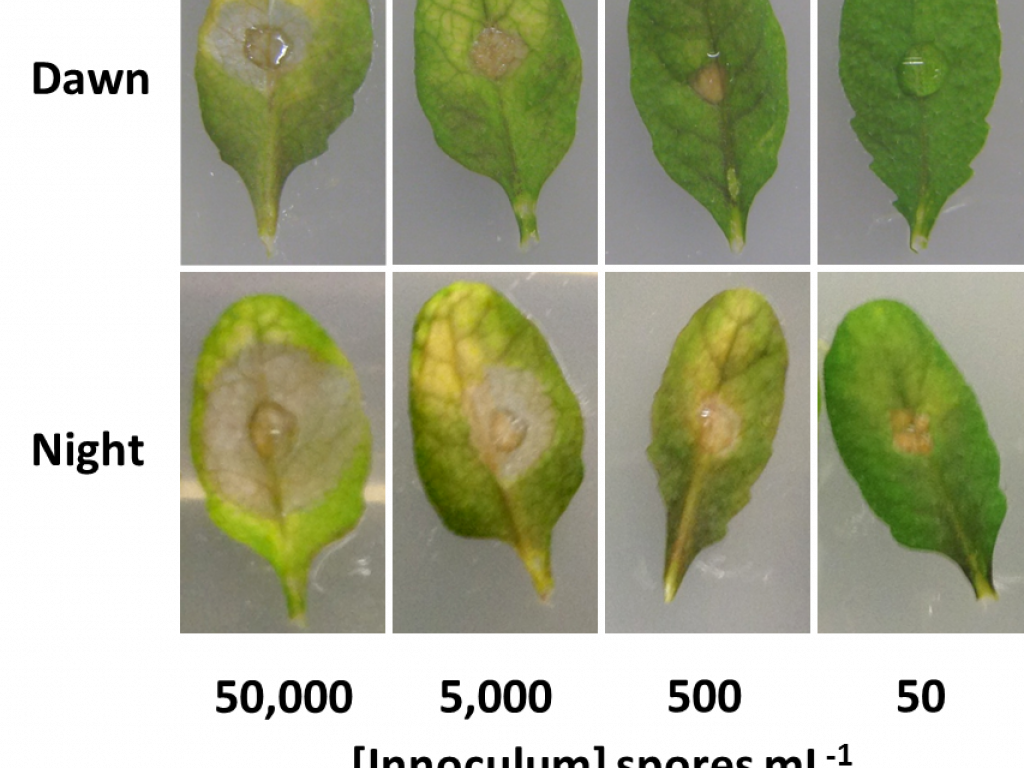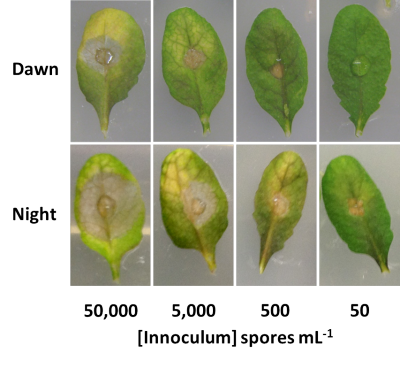Temporal regulation of plant defences


Detached leaves from four week-old Col-0 plants were inoculated at dawn or midnight with B. cinerea spores (ranging from 50 to 50,000 spores mL-1) and disease symptoms assayed at 72 hpi. The size of the lesion indicates the success of the infection or defence response.
Plants are able to anticipate changes in the daily environment, such as sunrise and sunset, temperature and even likelihood of pathogen infection. They are able to do this as they have a molecular clockwork mechanism called the circadian clock. Drs Laura Roden and Rob Ingle from the Department of Molecular & Cell Biology at UCT, lead a study that demonstrated that plant defence responses to bacterial infection are regulated according to time of day of infection, implicating the circadian clock in defence control.
Plants possess a robust multi-layered defence system to respond to attack by pathogens in their environment. Botrytis cinerea is an important fungal plant-pathogen with a broad host range, feeding on dead plant tissues. Plants are infected mainly through spores which are released from infected material when disturbed, or by water splash. Roden and Ingle have found that inoculation of the small weed Arabidopsis thaliana, used as a model plant system, with B. cinerea has different outcomes depending on the time of the day at which plants are inoculated with spores (Ingle et al., 2015). A Chilean group showed earlier this year that B. cinerea itself has a clock that is important in determining its virulence. Plant defences may be temporally regulated such that they are strongest at the time of maximal vulnerability to infection, e.g. against bacterial pathogens when stomata are open, or to coincide with the time of day when a pathogen is most abundant, or conditions are most favourable for pathogen growth. Fungal spore release is generally diurnally regulated with many species releasing spores nocturnally, resulting in maximal spore concentrations in the early morning. Ingle and Roden, together with collaborators at the University of Warwick in the UK, have now established that clock control of plant defence responses is achieved through rhythmic expression of key transcription factors (proteins that turn genes on or off) in the defence network, resulting in time-of-infection dependent variation in signalling through the network. They found that the defence response to B. cinerea, in terms of increase or decrease of defence gene expression, is delayed in plants inoculated at night – when spores would usually be less abundant. The temporal differences in the plant’s response to pathogen infection appear to be due to delays in signalling at times of day when expression of the appropriate transcription factor(s) is low. This may have implications for management of bacterial and fungal infections of crops, in terms of effective times for application of treatments, as well as in plant breeding for resistance.
